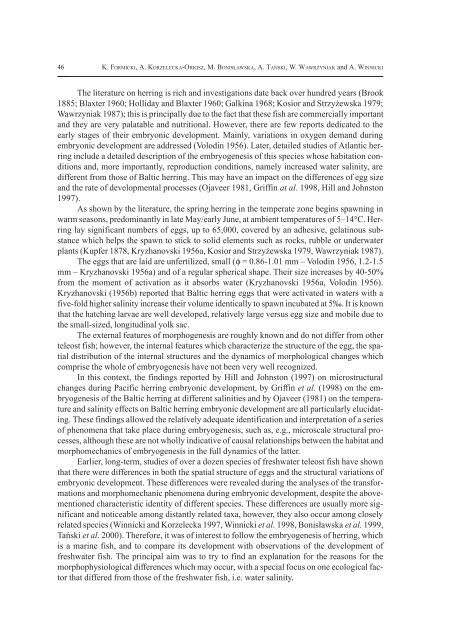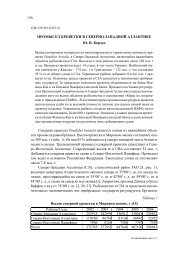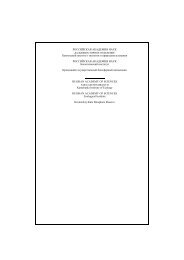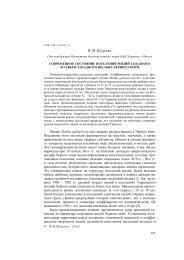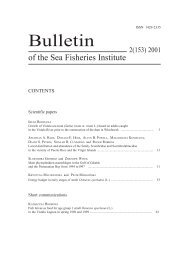Bulletin of the Sea Fisheries Institute 2 (156) 2002 - CEEMaR
Bulletin of the Sea Fisheries Institute 2 (156) 2002 - CEEMaR
Bulletin of the Sea Fisheries Institute 2 (156) 2002 - CEEMaR
You also want an ePaper? Increase the reach of your titles
YUMPU automatically turns print PDFs into web optimized ePapers that Google loves.
46 K. FORMICKI, A. KORZELECKA-ORKISZ, M. BONIS£AWSKA, A. TAÑSKI, W. WAWRZYNIAK and A. WINNICKI<br />
The literature on herring is rich and investigations date back over hundred years (Brook<br />
1885; Blaxter 1960; Holliday and Blaxter 1960; Galkina 1968; Kosior and Strzy¿ewska 1979;<br />
Wawrzyniak 1987); this is principally due to <strong>the</strong> fact that <strong>the</strong>se fish are commercially important<br />
and <strong>the</strong>y are very palatable and nutritional. However, <strong>the</strong>re are few reports dedicated to <strong>the</strong><br />
early stages <strong>of</strong> <strong>the</strong>ir embryonic development. Mainly, variations in oxygen demand during<br />
embryonic development are addressed (Volodin 1956). Later, detailed studies <strong>of</strong> Atlantic herring<br />
include a detailed description <strong>of</strong> <strong>the</strong> embryogenesis <strong>of</strong> this species whose habitation conditions<br />
and, more importantly, reproduction conditions, namely increased water salinity, are<br />
different from those <strong>of</strong> Baltic herring. This may have an impact on <strong>the</strong> differences <strong>of</strong> egg size<br />
and <strong>the</strong> rate <strong>of</strong> developmental processes (Ojaveer 1981, Griffin at al. 1998, Hill and Johnston<br />
1997).<br />
As shown by <strong>the</strong> literature, <strong>the</strong> spring herring in <strong>the</strong> temperate zone begins spawning in<br />
warm seasons, predominantly in late May/early June, at ambient temperatures <strong>of</strong> 5–14°C. Herring<br />
lay significant numbers <strong>of</strong> eggs, up to 65,000, covered by an adhesive, gelatinous substance<br />
which helps <strong>the</strong> spawn to stick to solid elements such as rocks, rubble or underwater<br />
plants (Kupfer 1878, Kryzhanovski 1956a, Kosior and Strzy¿ewska 1979, Wawrzyniak 1987).<br />
The eggs that are laid are unfertilized, small (φ = 0.86-1.01 mm – Volodin 1956, 1.2-1.5<br />
mm – Kryzhanovski 1956a) and <strong>of</strong> a regular spherical shape. Their size increases by 40-50%<br />
from <strong>the</strong> moment <strong>of</strong> activation as it absorbs water (Kryzhanovski 1956a, Volodin 1956).<br />
Kryzhanovski (1956b) reported that Baltic herring eggs that were activated in waters with a<br />
five-fold higher salinity increase <strong>the</strong>ir volume identically to spawn incubated at 5‰. It is known<br />
that <strong>the</strong> hatching larvae are well developed, relatively large versus egg size and mobile due to<br />
<strong>the</strong> small-sized, longitudinal yolk sac.<br />
The external features <strong>of</strong> morphogenesis are roughly known and do not differ from o<strong>the</strong>r<br />
teleost fish; however, <strong>the</strong> internal features which characterize <strong>the</strong> structure <strong>of</strong> <strong>the</strong> egg, <strong>the</strong> spatial<br />
distribution <strong>of</strong> <strong>the</strong> internal structures and <strong>the</strong> dynamics <strong>of</strong> morphological changes which<br />
comprise <strong>the</strong> whole <strong>of</strong> embryogenesis have not been very well recognized.<br />
In this context, <strong>the</strong> findings reported by Hill and Johnston (1997) on microstructural<br />
changes during Pacific herring embryonic development, by Griffin et al. (1998) on <strong>the</strong> embryogenesis<br />
<strong>of</strong> <strong>the</strong> Baltic herring at different salinities and by Ojaveer (1981) on <strong>the</strong> temperature<br />
and salinity effects on Baltic herring embryonic development are all particularly elucidating.<br />
These findings allowed <strong>the</strong> relatively adequate identification and interpretation <strong>of</strong> a series<br />
<strong>of</strong> phenomena that take place during embryogenesis, such as, e.g., microscale structural processes,<br />
although <strong>the</strong>se are not wholly indicative <strong>of</strong> causal relationships between <strong>the</strong> habitat and<br />
morphomechanics <strong>of</strong> embryogenesis in <strong>the</strong> full dynamics <strong>of</strong> <strong>the</strong> latter.<br />
Earlier, long-term, studies <strong>of</strong> over a dozen species <strong>of</strong> freshwater teleost fish have shown<br />
that <strong>the</strong>re were differences in both <strong>the</strong> spatial structure <strong>of</strong> eggs and <strong>the</strong> structural variations <strong>of</strong><br />
embryonic development. These differences were revealed during <strong>the</strong> analyses <strong>of</strong> <strong>the</strong> transformations<br />
and morphomechanic phenomena during embryonic development, despite <strong>the</strong> abovementioned<br />
characteristic identity <strong>of</strong> different species. These differences are usually more significant<br />
and noticeable among distantly related taxa, however, <strong>the</strong>y also occur among closely<br />
related species (Winnicki and Korzelecka 1997, Winnicki et al. 1998, Bonis³awska et al. 1999,<br />
Tañski et al. 2000). Therefore, it was <strong>of</strong> interest to follow <strong>the</strong> embryogenesis <strong>of</strong> herring, which<br />
is a marine fish, and to compare its development with observations <strong>of</strong> <strong>the</strong> development <strong>of</strong><br />
freshwater fish. The principal aim was to try to find an explanation for <strong>the</strong> reasons for <strong>the</strong><br />
morphophysiological differences which may occur, with a special focus on one ecological factor<br />
that differed from those <strong>of</strong> <strong>the</strong> freshwater fish, i.e. water salinity.


